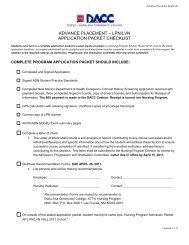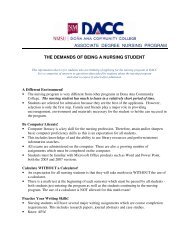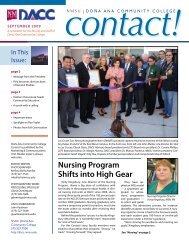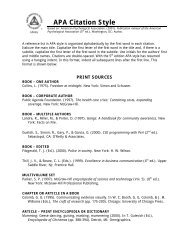Download - Dona Ana Community College
Download - Dona Ana Community College
Download - Dona Ana Community College
You also want an ePaper? Increase the reach of your titles
YUMPU automatically turns print PDFs into web optimized ePapers that Google loves.
DACC Nursing Program Student Handbook 2012-201312. Fails to interact effectively with health team. (i.e., attitude adversely affects the patient; fails torecall/share necessary information with team; personality conflicts interfere with the efficientfunctioning of the unity/team.)4.10 WORKING PRIOR TO CLINICALStudents shall not work within eight hours prior to a clinical assignment. If it is determined that thestudent has failed to comply with this policy, the clinical instructor shall dismiss the student from theclinical assignment and they shall incur a clinical absence.4.11 BLOOD BORNE PATHOGENS – UNIVERSAL PRECAUTIONSBlood borne pathogen means pathogenic microorganisms that are present in human blood and cancause disease in humans. In the practice of nursing, a student is at risk for an occupational exposure. Thestudent shall come in contact with and be exposed to blood, body fluids, contaminated articles and otherpotentially infectious materials. It is the student‘s responsibility to be aware of safety precautions andutilize safe practice techniques. The following descriptions refer to contamination, exposure andpotential infected materials: Contaminated: Presence or the reasonably anticipated presence of blood or other potentiallyinfectious materials on an item or surface. Contaminated Laundry: Laundry which has been soiled with blood or other potentiallyinfectious materials or may contain sharps. Contaminated Sharps: Any contaminated object that can penetrate the skin including, but notlimited to, needles, scalpels, broken glass, broken capillary tubes, and exposed ends of dentalwires. Occupational Exposure: Reasonably anticipated skin, eye, mucous membrane, or parenteralcontact with blood or other potentially infectious materials that may result from the performanceof any duties. Parenteral: Piercing mucous membranes or the skin barrier through such events as needle sticks,human bites, cuts, and abrasions. Potentially Infectious Materials: (1) The following human body fluids: semen, vaginalsecretions, cerebrospinal fluid, synovial fluid, pleural fluid, pericardial fluid, peritoneal fluid,amniotic fluid, saliva in dental procedures, any body fluid that is visibly contaminated withblood, and all body fluids in situations where it is difficult or impossible to differentiate betweenbody fluids; (2) Any unfixed tissue or organ (other than intact skin) from a human (living ordead); and (3) HIV-containing cell or tissue cultures, organ cultures, and HIV- or HBVcontainingculture medium or other solutions; and blood, organs, or other tissues fromexperimental animals infected with HIV or HBV.Exposure Incident: A specific eye, mouth, other mucous membrane, non-intact skin, or parenteralcontact with blood or other potentially infectious materials that results from the performance of duties.Standard precautions is the concept that all human blood and certain human body fluids are treated asif known to be infectious for HIV, HBV (hepatitis B virus) and other blood borne pathogens. Standardprecautions shall be observed to prevent contact with blood and other potentially infectious materials.35 | P a g e







